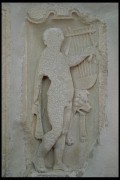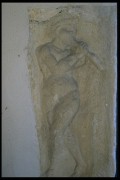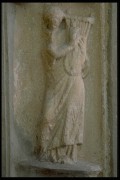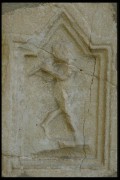
Image a) | 
Image b) | 
Image c) | 
Image d) | 
Image e) | 
Image f) | |
Examples a-f show Hercules and Orpheus, young men dancing, a Bacchante and a Muse, some of whom are holding musical instruments. These art works are closely related to the cult of Bacchus: dance leads to ecstasy which explains why such themes were commonly used to decorate tombs. There is a certain development from the ecstatic orgiastic celebration to a kind of ethereal philosophical view of death. a) Hercules is shown here as the leader of the muses (Hercules musarum), thus combining strength with beauty. This white marble relief was probably used as a part of a tomb (2nd century A.D.) and is currently conserved in Seggau Castle. b) This relief on a marble block shows a dancing satyr with an Aulos, i.e. a wind instrument with two oboe-like tubes (2.-4. century A.D.). It is currently kept at Seggau Castle. c) Also preserved at Seggau Castle is the relief of a drum-playing dancing menade (tympanon = frame drum), dating from the 2nd to the 4th century A.D.). d) This relief of the muse of stringed instruments is located at the church of St. Johnnear Herberstein (Styria) 3rd c. A.D. e) this dancing boy originally came from the cornerstone of a Roman mausoleum and is currently in the outer wall of St. John's church near Herberstein. f) The large stone plate decorated with a relief
is known as the Orpheus of Enns. It was taken from a roman tomb and used
as the top of an early Christian stone box grave but with the relief
facing down. (E. Stadler)
| 


